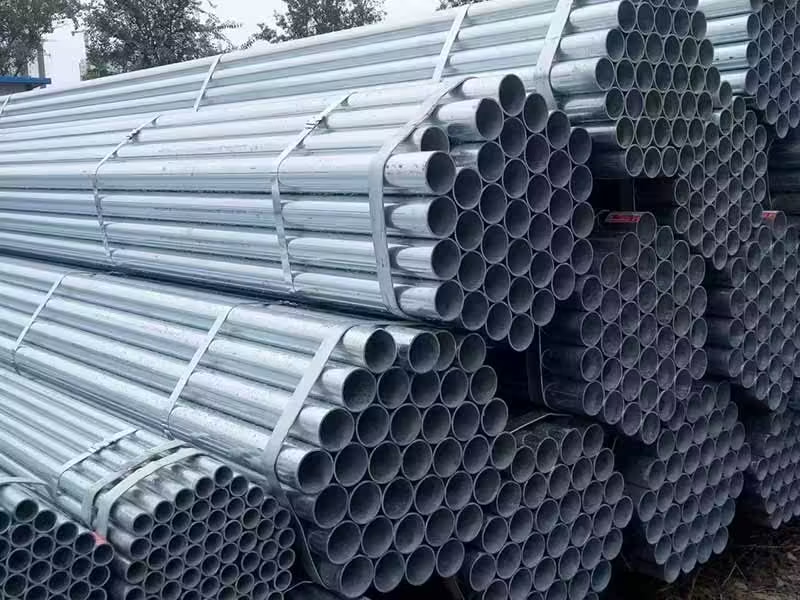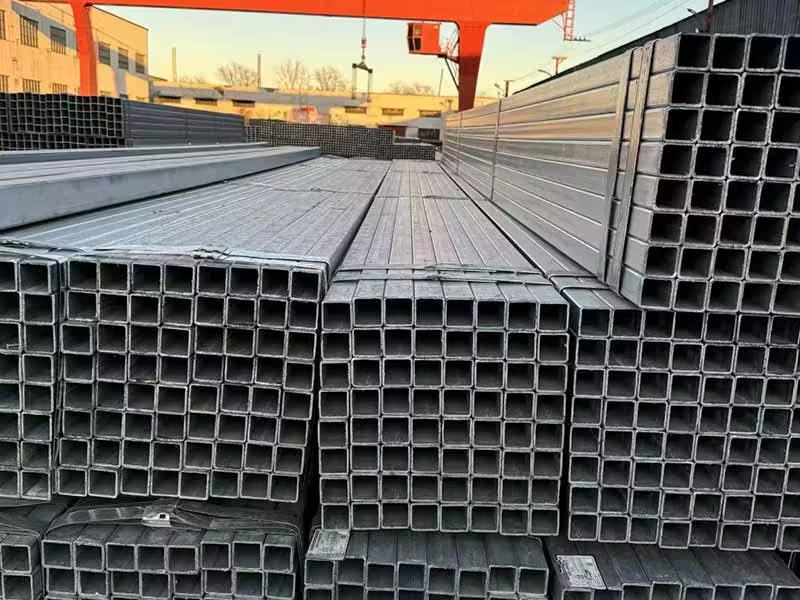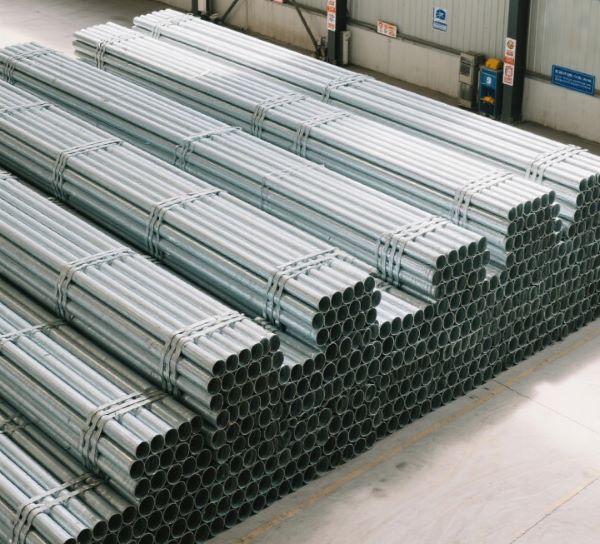مرحباً بكم في مدونتي!
قبل أن نتعمق في المحتوى، يسعدني انضمامكم إليّ على منصاتي للتواصل الاجتماعي، حيث أشارك المزيد من الأفكار، وأتفاعل مع المجتمع، وأنشر التحديثات. إليكم كيفية التواصل معي:
فيسبوك:https://www.facebook.com/profile.php?id=61571539990739
لنبدأ رحلتنا معًا. آمل أن تجدوا هذا المحتوى ثريًا وجذابًا وقيّمًا.
جدول المحتويات
مقدمة

عندما تكون المتانة أمرًا بالغ الأهمية، غالبًا ما تُصبح أنابيب الحديد المجلفن الخيار الأمثل. فطلاؤها بالزنك يحمي الفولاذ من الداخل، مما يجعلها خيارًا موثوقًا به في أعمال السباكة والبناء والتطبيقات الخارجية. ولكن هل تدوم طويلًا حقًا؟ في هذه المقالة، سنستكشف ماهية أنابيب الحديد المجلفن، وكيفية عملها، وأين تحقق أفضل أداء.
ما هو أنبوب الحديد المجلفن وكيف يتم تصنيعه
أنبوب الحديد المجلفن هو في الأساس أنبوب فولاذي مطلي بطبقة واقية من الزنك. تُعرف هذه العملية باسم الجلفنة بالغمس الساخن، وتتضمن غمر الفولاذ في الزنك المصهور. بمجرد أن يبرد، يُشكل الطلاء حاجزًا يمنع التآكل. مع مرور الوقت، يتفاعل الزنك مع البيئة مُكوّنًا أكسيد الزنك ثم كربونات الزنك، وكلاهما مستقر ومقاوم للتآكل.
لا يقتصر هذا الطلاء على مقاومة الصدأ فحسب، بل يعمل أيضًا كطبقة تضحية. ببساطة، يتآكل الزنك بدلًا من الفولاذ. إنها ميزة تُطيل عمر الأنبوب بشكل ملحوظ في ظل الظروف المناسبة.
فوائد أنابيب الحديد المجلفن في التطبيقات العملية
يوفر أنبوب الحديد المجلفن مزيجًا من القوة ومقاومة التآكل والأسعار المعقولة. ولذلك يُستخدم على نطاق واسع في:
- أنظمة الدعم الهيكلي مثل الدرابزين والسياج
- الأنابيب تحت الأرض للمياه غير الصالحة للشرب
- دعامات قنوات التدفئة والتهوية وتكييف الهواء والأطر الميكانيكية
- لافتات خارجية وأعمدة إنارة الشوارع
كما أنه سهل المنال من حيث التكلفة والتوافر، مما يجعله خيارًا عمليًا للمشاريع الكبيرة. للاستخدام الخارجي العام، يوفر طلاء الزنك حماية لأكثر من 50 عامًا. وفي البيئات الداخلية الجافة، قد يدوم الأنبوب حتى 70 عامًا أو أكثر دون الحاجة إلى صيانة كبيرة.
حدود أنابيب الحديد المجلفن

على الرغم من مزاياها، فإن أنابيب الحديد المجلفن ليست مثالية لجميع البيئات. يكمن التحدي الأكبر في التآكل الداخلي، خاصةً في الأنظمة التي يكون فيها الماء راكدًا أو يتدفق بشكل غير منتظم. مع مرور الوقت، قد تصدأ الجدران الداخلية وتتقشر، مما يؤدي إلى تقييد تدفق المياه أو حتى تسربها.
في البيئات عالية الرطوبة أو الحمضية، تتآكل طبقة الزنك بشكل أسرع، مما يكشف الفولاذ تحتها. وبالمثل، يمكن أن تُسرّع البيئات القلوية أو الغنية بالمواد الكيميائية من التلف. لذلك، من الضروري تجنب استخدام أنابيب الحديد المجلفن في المناطق التي يكون فيها مستوى الرقم الهيدروجيني (pH) متفاوتًا للغاية.
هناك قلق آخر يتعلق بالسلامة في أنظمة السباكة القديمة. فالأنابيب المُركّبة منذ عقود قد تحتوي على رصاص أو تتكوّن عليها رقائق صدأ تؤثر على جودة المياه. ورغم تحسّن معايير الإنتاج الحديثة، لا يزال هذا الأمر يُنصح بمراقبته عند العمل على بنية تحتية قديمة أو إعادة استخدامها.
متوسط العمر المتوقع في ظروف مختلفة
فيما يلي دليل عام حول المدة التي يمكنك أن تتوقع أن تستمر فيها أنابيب الحديد المجلفن، اعتمادًا على الظروف:
| بيئة التطبيق | العمر المتوقع |
|---|---|
| المناطق الداخلية الجافة | 50-70 سنة |
| خارجي (غير صناعي) | 40-50 سنة |
| البيئات الرطبة أو شبه الرطبة | 10-20 سنة |
| أنظمة المياه المحاصرة | 2-5 سنوات |
تسمح المناطق الجافة وجيدة التهوية لطلاء الزنك بتكوين طبقة خارجية متينة تحمي الفولاذ تحته. في المقابل، تُقصّر البيئات التي تحتجز الماء أو تحتوي على مواد كيميائية قاسية عمر الأنبوب بشكل كبير.
كيفية إطالة عمر خدمة أنابيب الحديد المجلفن

لتحقيق أقصى استفادة من أنابيب الحديد المجلفن، من الضروري استخدامها في الأماكن التي تحقق أفضل أداء، وتطبيق استراتيجيات صيانة دورية. إليك بعض النصائح العملية:
- اختر البيئات ذات تدفق الهواء الجيد وتراكم الرطوبة إلى الحد الأدنى
- تجنب استخدام الأنابيب المجلفنة في أنظمة الرشاشات لمكافحة الحرائق أو خطوط المياه المغلقة
- فحص دوري بحثًا عن الصدأ أو التقشر أو تراكم القشور
- فكر في تطبيق طلاءات إضافية إذا تعرض الأنبوب للأحماض أو الأملاح
- يمكن دمجه مع التركيبات غير المسببة للتآكل لتقليل فرصة حدوث التفاعلات الكيميائية
يمكن أن تساعد هذه الاستراتيجيات في إطالة عمر الأنبوب ومنع حدوث أعطال غير متوقعة في النظام.
خاتمة
اكتسبت أنابيب الحديد المجلفن سمعة طيبة بفضل متانتها ومقاومتها للتآكل، خاصةً في البيئات ذات الهواء الجاف والتعرض المحدود للمواد الكيميائية. ولكن، كأي مادة أخرى، لها حدود. ففي ظل ظروف سيئة أو دون رعاية مناسبة، حتى الأنابيب المجلفنة قد تتلف مبكرًا.
إذا فهمتَ كيفية ومكان استخدام هذا النوع من الأنابيب، فسيدوم لعقود. صحيحٌ أنه لن يدوم للأبد، ولكن مع الإعداد الصحيح، قد يدوم لفترةٍ قريبةٍ جدًا.
الأسئلة الشائعة
ما هي استخدامات أنابيب الحديد المجلفن؟
يتم استخدامه بشكل شائع في السباكة والبناء وأنظمة التدفئة والتهوية وتكييف الهواء والهياكل الخارجية مثل الأسوار والأعمدة.
ما هي مدة صلاحية أنابيب الحديد المجلفن؟
في الظروف المثالية، يمكن أن يدوم من ٥٠ إلى ٧٠ عامًا. أما في البيئات القاسية والرطبة، فقد ينخفض عمره إلى بضع سنوات فقط.
هل يمكنني استخدام الأنابيب المجلفنة لمياه الشرب؟
على الرغم من أن هذه المادة كانت شائعة في أنظمة مياه الشرب، إلا أن المعايير الحديثة غالبًا ما تتجنبها بسبب المخاوف بشأن الرصاص والتآكل الداخلي.
كيف يتم مقارنته بالفولاذ المقاوم للصدأ؟
تعتبر الأنابيب المجلفنة أرخص وأسهل في التركيب ولكنها لا توفر نفس مقاومة التآكل مثل الفولاذ المقاوم للصدأ.
هل يمكن لحام الأنابيب المجلفنة؟
نعم، ولكن يجب إجراء اللحام بحذر. يُنتج طلاء الزنك أبخرة سامة عند تسخينه، لذا فإن التهوية الجيدة وإجراءات السلامة ضرورية.

